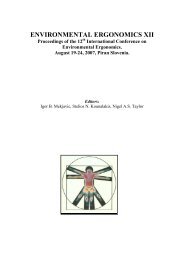Development of self-compacting concrete
Development of self-compacting concrete
Development of self-compacting concrete
Create successful ePaper yourself
Turn your PDF publications into a flip-book with our unique Google optimized e-Paper software.
oth the precast and ready-mix markets in the UK, Europe and<br />
the rest <strong>of</strong> the world is expected to continue to increase. The<br />
main drivers for this increase in use are expected to include<br />
• an increase in the experience <strong>of</strong> both producers,<br />
contractors, designers and clients<br />
• an increase in available guidance on the production, design<br />
and use <strong>of</strong> SCC<br />
• a decrease in the unit cost <strong>of</strong> the material as technology<br />
and experience improves<br />
• the demand from clients for a higher-quality finished<br />
product<br />
• the decrease in skilled labour available in many countries<br />
for both the placing and finishing <strong>of</strong> <strong>concrete</strong>.<br />
7. ACKNOWLEDGEMENTS<br />
The author wishes to acknowledge the support provided in<br />
collating the information for this paper from the BRE<br />
Framework contract on SCC, which is currently being<br />
undertaken by BRE for the Construction Industry Directorate,<br />
DTI. The author also wishes to thank the industry participants<br />
in this programme, including BCA, Concrete Admixtures<br />
Association, Concrete Society, John Doyle Construction Ltd,<br />
Lafarge UK Ltd, Mott MacDonald Ltd, RMC Readymix Ltd and<br />
the University <strong>of</strong> Paisley, as well as the many individuals who<br />
have supplied the information required in the writing <strong>of</strong> this<br />
paper.<br />
REFERENCES<br />
1. OKAMURA H., OZAWA K. and OUCHI M. Self-<strong>compacting</strong><br />
<strong>concrete</strong>. Structural Concrete, 2000, 1, No.1, Mar., 3–17.<br />
2. TANIGAWA Y., MORI H., YONEZAWA T., IZUMI I. and MITSUI K.<br />
Evaluation <strong>of</strong> the flowability <strong>of</strong> high-strength <strong>concrete</strong> by<br />
L-flow test. Proceedings <strong>of</strong> the Annual Conference <strong>of</strong> the<br />
Architectural Institute <strong>of</strong> Japan, 1989/1990.<br />
3. OZAWA K., MAEKAWA K. and OKAMURA H. High performance<br />
<strong>concrete</strong> with high filling ability. Proceedings <strong>of</strong> the RILEM<br />
Symposium, Admixtures for Concrete, Barcelona, 1990.<br />
4. TANGTERMSIRIKUL S., SAKAMOTO J., SHINDOH T. and<br />
MATSUOKA Y. Evaluation <strong>of</strong> resistance to segregation <strong>of</strong><br />
super workable <strong>concrete</strong> and the role <strong>of</strong> a new type <strong>of</strong><br />
viscosity agent. Reports <strong>of</strong> the Technical Research<br />
Institution, 1991, Taise: Corporation, Japan, No. 24,<br />
pp. 369–376.<br />
5. OZAWA K., MAEKAWA K. and OKAMURA H. <strong>Development</strong> <strong>of</strong><br />
High Performance Concrete. University <strong>of</strong> Tokyo, 1992,<br />
Faculty <strong>of</strong> Engineering journal.<br />
6. SAKAMOTO J., MATSUOKA Y., SHINDOH T. and<br />
TANGTERMSIRIKUL S. Application <strong>of</strong> super workable <strong>concrete</strong><br />
to actual construction. Proceedings <strong>of</strong> Concrete 2000<br />
Conference, University <strong>of</strong> Dundee, 1993.<br />
7. KUROIWA S., MATSUOKA Y., HAYAKAWA M. and SHINDOH T.<br />
Application <strong>of</strong> Super Workable Concrete to Construction <strong>of</strong><br />
a 20-storey Building. ACI, 1993, SP-140.<br />
8. OZAWA K., SAKATA N. and OKAMURA H. Evaluation <strong>of</strong> <strong>self</strong>compactability<br />
<strong>of</strong> fresh <strong>concrete</strong> using the funnel test.<br />
Concrete Library <strong>of</strong> JSCE, No. 25, 1995.<br />
9. OUCHI M. and OZAWA K. (eds). Proceedings <strong>of</strong> the<br />
International Workshop on Self-Compacting Concrete,<br />
Kochi, 1998, Japan Society <strong>of</strong> Civil Engineers, ISBN<br />
4-8106-0310-5.<br />
10. UOMOTO T. and OZAWA K. (eds). Recommendation for SCC.<br />
JSCE Concrete Engineering, Series 31, Tokyo, Japan,<br />
1999.<br />
11. OZAWA K. and OUCHI M. (eds). Proceedings <strong>of</strong> the 2nd<br />
International Symposium on Self-Compacting Concrete,<br />
Tokyo, 2001, 743, ISBN 4-90154-04-0 (www.infra.kochitech.ac.jp/sccnet/scc2/).<br />
12. Fib <strong>concrete</strong> structures in the 21st century. Proceedings <strong>of</strong><br />
the 1st Fib Congress, Osaka, 2002 (www.fib2002.com/e/<br />
index.html).<br />
13. DOMONE P. L. and CHAI H. W. Design and testing <strong>of</strong> SCC:<br />
Production methods and workability <strong>of</strong> <strong>concrete</strong>.<br />
Proceedings <strong>of</strong> an International RILEM Conference. E & F N<br />
Spon, London, 1996, ISBN 419 22070 4.<br />
14. PETERSSON O. and BILLBERG P. A model for SCC: Production<br />
methods and workability <strong>of</strong> <strong>concrete</strong>. International<br />
RILEM Conference. E & F N Spon, London, 1996,<br />
ISBN 419 22070 4.<br />
15. SKARENDAHL A. and PETERSSON Ö. (eds). Proceedings <strong>of</strong> the<br />
1st International RILEM Symposium on SCC. RILEM<br />
Publications, 1999, p. 786, ISBN 2-912143-09-8.<br />
16. BILLBERG P. Self-<strong>compacting</strong> <strong>concrete</strong> for civil engineering<br />
structures—the Swedish experience. Swedish Cement and<br />
Concrete Research Institute, Stockholm, 1999, CBI report<br />
2:99, p. 80.<br />
17. Details available on the internet at: http://scc.ce.luth.se.<br />
18. NILSSON M. Project on Self-<strong>compacting</strong> Bridge Concrete.<br />
Swedish National Road Administration (SNRA), 1998,<br />
Publication 1998:71 E, ISSN 1401-9612, p. 19.<br />
19. Details available on the internet at:<br />
www.acmcentre.com/testing-scc/index.php.<br />
20. RILEM. TC CSC: Casting <strong>of</strong> SCC,<br />
www.rilem.ens-cachan.fr/csc.<br />
21. BILLBERG P. CBI, Sweden. Personal communication,<br />
November 2002.<br />
22. EUROPEAN FEDERATION <strong>of</strong> PRODUCERS AND CONTRACTORS OF<br />
SPECIALIST PRODUCTS FOR STRUCTURES. Specification and<br />
Guidelines for SCC. EFNARC, 2002, ISBN 0-9539733-4-4,<br />
p. 29.<br />
23. EUROPEAN FEDERATION OF PRODUCERS AND CONTRACTORS OF<br />
SPECIALIST PRODUCTS FOR STRUCTURES (EFNARC).<br />
Specifications and Guidelines for Self-Compacting Concrete.<br />
EFNARC, Surrey, 2002. Also available on the internet at:<br />
www.efnarc.org.<br />
24. DINGENOUTS M. Review <strong>of</strong> SCC Product Acceptance<br />
Standardisation. Proceedings <strong>of</strong> Paisley University<br />
Workshop, September 2002.<br />
25. SKARENDAHL A. Swedish Construction Sector Innovation<br />
Centre, BIC. Personal communication, August 2002.<br />
26. GRAUERS M. NCC Construction Sverige AB, NCC<br />
Engineering, Sweden. Personal communication, July 2002.<br />
27. SWEDISH CONCRETE ASSOCIATION. SCC Recommendations for<br />
Use, SCA, 2002, Report series No. 10, p. 84.<br />
28. JOHANSEN K. Sintef, Trondheim, Norway. Personal<br />
communication, August 2002.<br />
29. KUKKO H. VTT Building and Transport, Finland. Personal<br />
communication, September 2002.<br />
30. DE LARRARD F. Laboratoire Central des Ponts et Chaussées,<br />
France. Personal communication, July 2002.<br />
31. ASSOCIATION FRANÇAISE DE GENIE CIVIL. Bétons Autoplaçants:<br />
Recommandations provisoires. AFGC, Bagneux,<br />
France, July 2000.<br />
Structures & Buildings 156 Issue SB4 Self-<strong>compacting</strong> <strong>concrete</strong> development<br />
Goodier 413
















